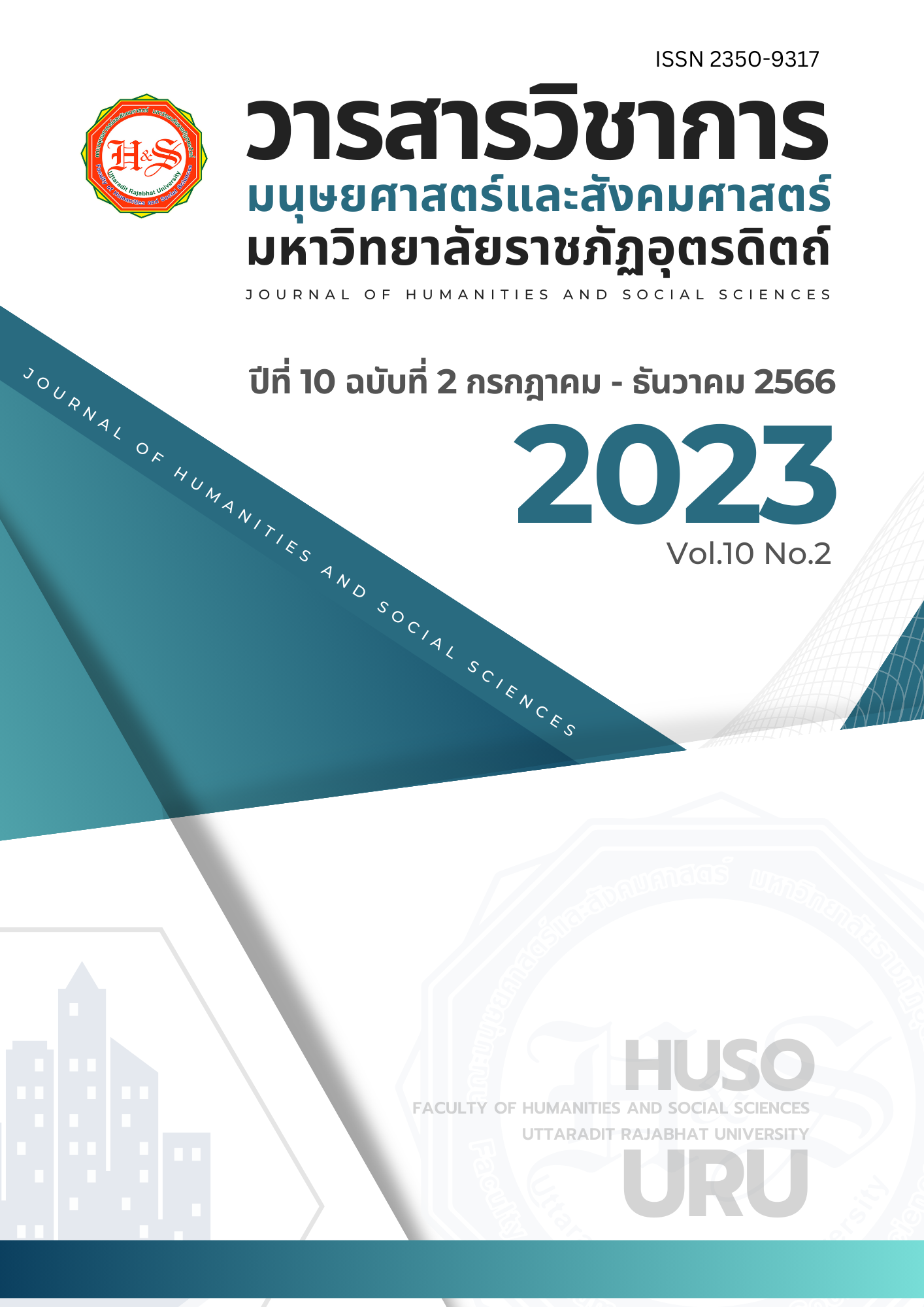An Ethnosemantic Study Of Taste Terms In Bisu
Keywords:
Bisu Taste Terms EthnosemanticAbstract
The purpose of this research was to study the structure of taste terms and its categorization in Bisu language. The data used in this research was done by asking informants to identify the tastes. The results show that there are two structures: simple and compound terms. The simple taste terms convey the structure and syntactic relation in the form Head-Modifier, Modifier-Head-Modifier.The compound taste terms are found that Head-Head and Head-Connective-Head.
The categorization of taste terms can be divided into 2 groups: prototype taste terms and non-prototype taste terms. There are 8 basic taste terms are/aŋʧaw/: sweet, /aŋblə/ : watery, /aŋʧɨ/:rich, /aŋʧen/:sour, /aŋkhà/:bitter, /aŋjáŋ/:salty, /aŋphan/:acidulous and /aŋphi/:spicy. There 14 non-basic taste terms categories in 4 categories: attitude (/aŋʦabɨ/:delicious and /kampɔ/:mellow), smell (/aŋhɔm/:scented, /aŋhnam/:stench,/aŋkhiw/:rank and /aŋsap/: fishy), sensation (/aŋʦɨ/:cool, /aŋhlɔŋ/:hot, /aŋhjàŋ/:itchy, /aŋsɨn/:moist, and /aŋhjam/: senseless) and texture (/aŋphɔj/:crispy, /aŋhnəŋ/:sticky and /aŋdɔ/:mild). Studies have shown that the Bisu people do not prioritize the main taste of their food. but pay more attention to the attitude towards this type of food and tend to eat foods based on their natural flavours and less food additives.
References
คณะมนุษยศาสตร์และสังคมศาสตร์ สถาบันราชภัฎเชียงราย. (2540). ข้อมูลชุมชน(พื้นที่สูง) กลุ่มชาติพันธุ์ละว้า บ้านดอยชมพู. [เอกสารอัดสำเนา]. เชียงราย : สถาบันราชภัฎเชียงราย.
ทีมวิจัยชุมชนชาวบีซู บ้านดอยชมภู ต.โป่งแพร่ อ.แม่ลาว จ.เชียงราย. (2559). บีซู จี่ต่าง อางเกิ่งอางกอ อางลีบอาง ลาว ภาษา วัฒนธรรม ประเพณีของชาวบีซู. สำนักงานกองทุนสนับสนุนการวิจัย (สกว.) ฝ่ายวิจัยเพื่อ ท้องถิ่น และศูนย์ศึกษาและฟื้นฟูภาษาและวัฒนธรรมในภาวะวิกฤต.
ธีระพันธุ์ ล.ทองคำ. (2535). คำเรียกสีในภาษาเย้า (เมี่ยน). กรุงเทพมหานคร : โครงการวิจัยภาษาและวัฒนธรรม หน่วยปฏิบัติการวิจัยทางภาษา คณะอักษรศาสตร์ จุฬาลงกรณ์มหาวิทยาลัย.
พรลัดดา เมฆบัณฑูรย์.(2547). การศึกษาคำเรียกรสและทัศนคติเกี่ยวกับรสในภาษาจีนแต้จิ๋วตามแนวอรรถศาสตร์ชาติพันธุ์. [วิทยานิพนธ์มหาบัณฑิต ไม่ได้ตีพิมพ์]. จุฬาลงกรณ์มหาวิทยาลัย.
ราชบัณฑิตยสถาน. (2556). พจนานุกรมฉบับราชบัณฑิตยสถาน 2554. กรุงเทพ : นานมีบุ๊ค, 2556.
โรงพยาบาลส่งเสริมสุขภาพตำบลห้วยส้านพลับพลา. (2565). สถิติผู้ป่วยโรคติดต่อไม่เรื้อรังบ้านดอยชมภู. [เอกสารอัดสำเนา]. เชียงราย : โรงพยาบาลส่งเสริมสุขภาพตำบลห้วยส้านพลับพลา.
ฤทัย พานิช. (2560). การศึกษาคำศัพท์พื้นฐานในภาษาบีซู: กรณีศึกษาคำศัพท์ทางภูมิศาสตร์. วารสารมนุษยศาสตร์สังคมศาสตร์ปริทัศน์. 4(2), 62-83.
สุพัตรา จิรนันทนาภรณ์ และอัญชลี สิงห์น้อย. (2552). รายงานการวิจัยคำเรียกรสของกลุ่มชาติพันธุ์ไทในเขต ภาคเหนือตอนล่าง : กรณีศึกษาในแนวอรรถศาสตร์ชาติพันธุ์. [เอกสารไม่ได้ตีพิมพ์] คณะมนุษยศาสตร์, มหาวิทยาลัยนเรศวร.
อมรา ประสิทธิ์รัฐสินธุ์.(2538). คำเรียกสีและการรับรู้สีของชาวจ้วงและชาวไทย. กรุงเทพมหานคร : โรงพิมพ์จุฬาลงกรณ์มหาวิทยาลัย, 2538.
อัญชลิกา ผาสุขกิจ. (2543). คำเรียกรสในภาษาไทยถิ่นตามแนวอรรถศาสตร์ชาติพันธุ์. [วิทยานิพนธ์มหาบัณฑิตไม่ได้ตีพิมพ์]. จุฬาลงกรณ์มหาวิทยาลัย.
อัญชลี สิงห์น้อย วงศ์วัฒนา, และสุพัตรา จิรนันทนาภรณ์. (2556). การศึกษาคำเรียกชื่อพืชในกลุ่มภาษาชาติพันธุ์ไท ในเขตภาคเหนือ. วารสารมหาวิทยาลัยนเรศวร. 21(1), 72-92.
Backhouse, A.E.(1994). The Lexical Field nof Taste :A Semantic Study of Japanese Taste Term. London: Cambridge University Press.
David Day, G.R. (2009). The Doi Chom Phu Bisu Noun Phrase. [Unpublished master’s Tnesis]. Payap University.
Hongli, J.(2005). A Study of Language use and Language Attitude among Bisu Speakers in China and Thailand. [Unpublished master’s Tnesis]. Payap University.
Downloads
Published
How to Cite
Issue
Section
License
Copyright (c) 2023 Journal of Humanities and Social Sciences Uttaradit Rajabhat University

This work is licensed under a Creative Commons Attribution-NonCommercial-NoDerivatives 4.0 International License.
บทความเป็นลิขสิทธิของคณะมส. มรภ อต.



